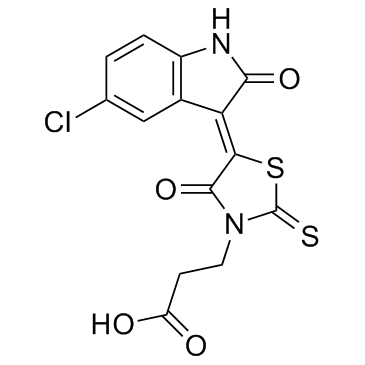| Description |
FX1 is a potent and specific BCL6 inhibitor, with an IC50 of around 35 μM.
|
| Related Catalog |
|
| Target |
IC50: ~35 μM (BCL6)[1]
|
| In Vitro |
DLBCL cells are exposed to 50 μM FX1 for 30 minutes. FX1 profoundly reduces recruitment of BCOR and SMRT to all 3 BCL6 target genes, but not at a negative control locus. There is little presence of SMRT at these loci in the BCL6-negative DLBCL cell line, which is not affected by FX1. The superior potency of FX1 versus 79-6 in disrupting BCL6 binding to SMRT is evident when these small molecules are compared head to head in quantitative ChIP assays in DLBCL cells after treatment with 50 μM FX1 for 6 hours. DLBCL cells are exposed to FX1 and mRNA is collect at 4 serial time points. FX1 almost invariantly induces significant derepression of these genes as compare with vehicle in 2 independent DLBCL cell lines[1].
|
| In Vivo |
Spleens in FX1-treating mice are macroscopically indistinguishable from vehicle controls. Total B cell abundance measured by flow cytometry is unaffected by FX1. GC B cells (GL7+FAS+B220+) are significantly depleted by exposure to FX1. Splenic architecture is examined by IHC. Staining with B220 antibody reveals normal B cell follicular structures, whereas staining for the GC B cell-specific marker peanut agglutinin shows profound loss of GCs. The half-life is estimated to be approximately 12 hours. Finally, whether FX1 can induce toxic effects in mice is assessed. No signs of toxicity, inflammation, or infection are evident from H&E-stained sections of lung, gastrointestinal tract, heart, kidney, liver, spleen, and bone marrow of the fixed organs from mice treated with FX1 compare with vehicle[1].
|
| Cell Assay |
Cell viability is determined with the fluorescent redox dye. Fluorescence is determined for 3 replicates per treatment condition or vehicle with the microplate reader. Cell viability of the drug-treated cells is normalized to their vehicle-treated controls, and the results are expressed as percentage viability. The drug effect as 100-percentage viability is calculated. Through dose-effect curves the drug concentration that inhibits the growth of cell lines by 50% compare with vehicle (GI50) is determined. Experiments are performed in triplicate. For combination treatments, cells are exposed to a dose curve of each drug alone or their combination in constant ratio, and cell viability is determined. To compare different schedules of treatments, the cells are treated in triplicate as follows: FX1 and doxorubicin simultaneously and cells treated for 48 hours; FX1 first and 24 hours after doxorubicin is added and treats for an extra 48 hours; doxorubicin first and 24 hours after FX1 is added and treats for an extra 48 hours. Then, the software is used to plot dose-effect curves and calculate the dose-reduction index[1].
|
| Animal Admin |
Six-to 8-week-old male mice are injected s.c. with 107 low-passage human SUDHL-6, OCI-Ly7, or Toledo cells. Alternatively, 6-to 8-week-old mice are injected with low-passage HBL-1 cells. When tumors reach a palpable size (approximately 100 mm3), mice are assigned in a randomized way to treatment groups and treated i.p. with 25 or 50 mg/kg/d of the drugs (including FX1). Drugs are reconstituted in PEG-400 and stored at -20°C until use. Tumor size is measured 3 times a week with an electronic digital caliper in 2 dimensions, and then tumor volume is calculated[1].
|
| References |
[1]. Mariano G et al. Rationally designed BCL6 inhibitors target activated B cell diffuse large B cell lymphoma. J Clin Invest. 2016 Sep 1; 126(9): 3351–3362.
|
